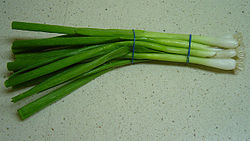葱
Appearance
| ||||||||
Translingual
[edit]Han character
[edit]
葱 (Kangxi radical 140, 艸+9, 15 strokes, cangjie input 廿心大心 (TPKP), composition ⿱艹怱)
Derived characters
[edit]References
[edit]- Kangxi Dictionary: page 1046, character 15
- Dai Kanwa Jiten: character 31454
- Dae Jaweon: page 1507, character 15
- Hanyu Da Zidian (first edition): volume 5, page 3253, character 11
- Unihan data for U+8471
Chinese
[edit]Glyph origin
[edit]| Old Chinese | |
|---|---|
| 牎 | *sʰroːŋ |
| 窗 | *sʰroːŋ |
| 窓 | *sʰroːŋ |
| 囱 | *sʰroːŋ, *sʰloːŋ |
| 總 | *ʔsloːŋʔ |
| 熜 | *ʔsloːŋʔ |
| 傯 | *ʔsloːŋʔ |
| 緫 | *ʔsloːŋʔ |
| 揔 | *ʔsloːŋʔ |
| 偬 | *ʔsloːŋʔ, *ʔsloːŋs |
| 囪 | *sʰloːŋ |
| 璁 | *sʰloːŋ |
| 驄 | *sʰloːŋ |
| 蔥 | *sʰloːŋ |
| 匆 | *sʰloːŋ |
| 怱 | *sʰloːŋ |
| 葱 | *sʰloːŋ |
| 楤 | *sʰloːŋ |
| 聦 | *sʰloːŋ |
| 繱 | *sʰloːŋ |
| 騘 | *sʰloːŋ |
| 鍯 | *sʰloːŋ |
| 聰 | *sʰloːŋ |
| 愡 | *sʰloːŋs |
| 檧 | *sloːŋ, *sloːŋʔ |
| 憽 | *sloːŋ |
| 幒 | *sʰloŋʔ, *kjoŋ |
Phono-semantic compound (形聲 / 形声, OC *sʰloːŋ): semantic 艸 (“grass”) + phonetic 怱 (OC *sʰloːŋ).
Definitions
[edit]| For pronunciation and definitions of 葱 – see 蔥 (“green onion; spring onion; scallion; etc.”). (This character is the simplified and variant traditional form of 蔥). |
Notes:
|
Usage notes
[edit]| Region | 蔥 | 葱 |
|---|---|---|
| Taiwan | standard | variant |
| Hong Kong | variant | standard |
Japanese
[edit]Kanji
[edit]葱
Readings
[edit]Compounds
[edit]Etymology
[edit]| Kanji in this term |
|---|
| 葱 |
| ねぎ Hyōgai |
| kun'yomi |
Compound of 根 (ne, “root”) + 葱 (ki, “onion”, older form).[1]
Pronunciation
[edit]Noun
[edit]- scallion, spring onion, Allium fistulosum
- Synonym: 白根 (shirone)
Derived terms
[edit]Idioms
[edit]- 鴨が葱を背負って来る (kamo ga negi o shottekuru)
Descendants
[edit]- → Atayal: negi'
References
[edit]- ^ Shōgaku Tosho (1988) 国語大辞典(新装版) [Unabridged Dictionary of Japanese (Revised Edition)] (in Japanese), Tōkyō: Shogakukan, →ISBN
- ^ NHK Broadcasting Culture Research Institute, editor (1998), NHK日本語発音アクセント辞典 [NHK Japanese Pronunciation Accent Dictionary] (in Japanese), Tokyo: NHK Publishing, Inc., →ISBN
Korean
[edit]Hanja
[edit]葱 • (chong) (hangeul 총, revised chong, McCune–Reischauer ch'ong, Yale chong)
- This term needs a translation to English. Please help out and add a translation, then remove the text
{{rfdef}}.
Categories:
- CJK Unified Ideographs block
- Han script characters
- Translingual lemmas
- Translingual symbols
- Han phono-semantic compounds
- Advanced Mandarin
- zh:Colors
- Chinese lemmas
- Mandarin lemmas
- Sichuanese lemmas
- Dungan lemmas
- Cantonese lemmas
- Taishanese lemmas
- Gan lemmas
- Hakka lemmas
- Jin lemmas
- Northern Min lemmas
- Eastern Min lemmas
- Hokkien lemmas
- Teochew lemmas
- Leizhou Min lemmas
- Puxian Min lemmas
- Southern Pinghua lemmas
- Wu lemmas
- Xiang lemmas
- Middle Chinese lemmas
- Old Chinese lemmas
- Chinese hanzi
- Mandarin hanzi
- Sichuanese hanzi
- Dungan hanzi
- Cantonese hanzi
- Taishanese hanzi
- Gan hanzi
- Hakka hanzi
- Jin hanzi
- Northern Min hanzi
- Eastern Min hanzi
- Hokkien hanzi
- Teochew hanzi
- Leizhou Min hanzi
- Puxian Min hanzi
- Southern Pinghua hanzi
- Wu hanzi
- Xiang hanzi
- Middle Chinese hanzi
- Old Chinese hanzi
- Chinese nouns
- Mandarin nouns
- Sichuanese nouns
- Dungan nouns
- Cantonese nouns
- Taishanese nouns
- Gan nouns
- Hakka nouns
- Jin nouns
- Northern Min nouns
- Eastern Min nouns
- Hokkien nouns
- Teochew nouns
- Leizhou Min nouns
- Puxian Min nouns
- Southern Pinghua nouns
- Wu nouns
- Xiang nouns
- Middle Chinese nouns
- Old Chinese nouns
- Chinese adjectives
- Mandarin adjectives
- Sichuanese adjectives
- Dungan adjectives
- Cantonese adjectives
- Taishanese adjectives
- Gan adjectives
- Hakka adjectives
- Jin adjectives
- Northern Min adjectives
- Eastern Min adjectives
- Hokkien adjectives
- Teochew adjectives
- Leizhou Min adjectives
- Puxian Min adjectives
- Southern Pinghua adjectives
- Wu adjectives
- Xiang adjectives
- Middle Chinese adjectives
- Old Chinese adjectives
- Chinese terms spelled with 葱
- Chinese simplified forms
- Chinese variant forms
- Japanese kanji
- Japanese hyōgai kanji
- Japanese kanji with goon reading す
- Japanese kanji with kan'on reading そう
- Japanese kanji with kun reading ねぎ
- Japanese terms spelled with 葱 read as ねぎ
- Japanese terms read with kun'yomi
- Japanese compound terms
- Japanese terms with IPA pronunciation
- Japanese lemmas
- Japanese nouns
- Japanese terms spelled with hyōgai kanji
- Japanese terms with 1 kanji
- Japanese terms spelled with 葱
- Japanese single-kanji terms
- ja:Alliums
- ja:Vegetables
- Korean lemmas
- Korean hanja
- CJKV simplified characters which already existed as traditional characters
